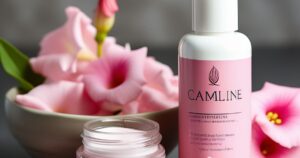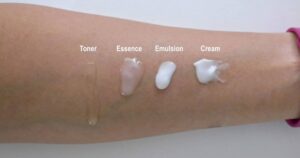Welcome to our expert guide on caring for combination skin, a unique and sometimes challenging skin type that requires specialized attention. Like a delicate balancing act, combination skin often presents both oily and dry areas, leaving you in a constant search for the perfect skincare routine. In this article, we will delve into the intricate world of combination skin, providing you with invaluable insights, tips, and techniques to achieve a harmonious and radiant complexion. Join us on this journey and unlock the secrets to healthy and balanced skin.
Key Takeaways
- Combination skin exhibits both oily and dry areas on the face.
- Determine if your skin is oily, dry, or a combination of both.
- Choose a gentle cleanser that effectively removes dirt, oil, and makeup without stripping the skin of its natural oils.
- Customize your skincare routine by choosing products that cater to both oily and dry areas of combination skin.
Understanding Combination Skin
Combination skin is a skin type that exhibits both oily and dry areas on the face. It is characterized by an oily T-zone (forehead, nose, and chin) while the cheeks and other areas tend to be dry. This can make it challenging to find a balance in skincare routines. Understanding combination skin is crucial in choosing the right skincare products and addressing common skin issues.
For those with combination skin, it is important to choose gentle cleansers that do not strip away natural oils from the dry areas while effectively removing excess oil in the T-zone. Moisturizers should be lightweight and non-greasy to hydrate the dry areas without exacerbating oiliness. Sunscreen is a must to protect the skin from sun damage.
Common skin issues for combination skin include enlarged pores, blackheads, and occasional acne breakouts. Using products with ingredients like salicylic acid or benzoyl peroxide can help in reducing these problems. Regular exfoliation and weekly face masks can also aid in keeping the skin balanced and healthy.
Identifying Your Skin’s Needs
To effectively care for your skin, it is essential to identify its specific needs and tailor your skincare routine accordingly. Understanding your skin’s needs can help you avoid common skincare mistakes and ensure that you are providing it with the right care. Here are some key factors to consider when identifying your skin’s needs:
- Skin type: Determine if your skin is oily, dry, or a combination of both. This will help you choose products that address specific concerns.
- Sensitivity: Assess whether your skin is sensitive to certain ingredients or environmental factors. This will guide you in selecting gentle, non-irritating products.
- Seasonal changes: Adjusting your skincare routine for different seasons is crucial. Cold weather may require more hydration, while hot and humid conditions may call for lighter, oil-free products.
Cleansing and Exfoliating for Balance
Effective cleansing and exfoliation are essential steps in achieving balanced and healthy skin for individuals with care of combination skin. Gentle products and targeted treatments can help to address the unique needs of this skin type. When it comes to cleansing, it is important to choose a gentle cleanser that effectively removes dirt, oil, and makeup without stripping the skin of its natural oils. Look for products that are specifically formulated for combination skin and avoid harsh ingredients that can cause dryness or irritation. Exfoliation is also crucial for maintaining balance in combination skin. A gentle exfoliator can help to remove dead skin cells and unclog pores, reducing the risk of breakouts. However, it is important not to over-exfoliate, as this can cause irritation and dryness. Aim to exfoliate 1-2 times per week and choose products with gentle exfoliating ingredients, such as alpha hydroxy acids or enzymes. By incorporating gentle cleansing and targeted exfoliation into your skincare routine, you can achieve a balanced and healthy complexion.
Hydration and Moisturization Tips
Proper hydration and moisturization are essential for maintaining the health and balance of combination skin. Here are some hydration techniques and moisturization tips to help you take care of your skin:
- Hydration Techniques:
- Drink plenty of water throughout the day to keep your skin hydrated from within.
- Use a hydrating toner or facial mist to replenish moisture levels and soothe your skin.
- Apply a hydrating serum or essence before moisturizing to provide an extra boost of hydration.
- Importance of Sunscreen:
- Protect your skin from harmful UV rays by using a broad-spectrum sunscreen with at least SPF 30.
- Apply sunscreen generously and reapply every two hours, especially when outdoors.
- Look for lightweight, non-greasy formulas that won’t clog your pores.
Customizing Your Skincare Routine
Creating a personalized skincare routine is crucial for effectively addressing the unique needs of combination skin. By customizing your skincare routine, you can target specific concerns and maintain a healthy balance between oily and dry areas. When selecting products for combination skin, it is important to choose those that cater to both skin types. Look for lightweight, oil-free moisturizers that hydrate without clogging pores. Additionally, using a gentle cleanser twice a day can help remove excess oil and impurities without stripping the skin of its natural moisture. Incorporating exfoliation into your routine can also help unclog pores and prevent breakouts. However, it is important to avoid common skincare mistakes such as over-exfoliating or using harsh products, as this can irritate the skin and disrupt its balance. Remember, consistency is key when it comes to skincare, so stick to your personalized routine and be patient for the best results.
Frequently Asked Questions
Can Combination Skin Change Over Time or With Age?
Combination skin changes over time and can be influenced by aging effects. As individuals age, their skin’s oil production and hydration levels may fluctuate, leading to shifts in the combination skin type.
Are There Any Specific Dietary Considerations for Managing Combination Skin?
Dietary influences play a role in managing combination skin. It is important to maintain a balanced diet rich in vitamins, minerals, and antioxidants. Additionally, following a consistent skincare routine tailored to your skin’s needs is crucial for optimum results.
How Can I Prevent Breakouts on My Oily T-Zone Without Drying Out the Rest of My Face?
To prevent breakouts on your oily T-zone without drying out the rest of your face, it’s important to maintain a balanced moisture level. This can be achieved through proper cleansing, exfoliation, and the use of oil-free moisturizers in the T-zone area.
Is It Necessary to Use Separate Products for Different Areas of My Combination Skin?
It is not always necessary to use separate products for different areas of combination skin. However, incorporating a balanced skincare routine and selecting the best products for combination skin can help maintain a healthy complexion.
Can Weather or Climate Affect the Balance of Combination Skin?
The impact of weather or climate on the balance of combination skin is significant. Changes in temperature, humidity, and environmental factors can affect the oiliness and dryness of different areas, requiring tailored skincare routines for optimum skin health.
Conclusion
In conclusion, caring for combination skin requires a tailored approach that balances both oily and dry areas. Understanding your skin’s needs and using appropriate cleansers and exfoliators can help maintain its balance. Hydration and moisturization are crucial to prevent dryness and control excess oil production. By customizing your skincare routine and following these tips, you can achieve a healthy and radiant complexion. Interestingly, studies have shown that approximately 70% of people have combination skin, making it a common skin type that requires special attention.









